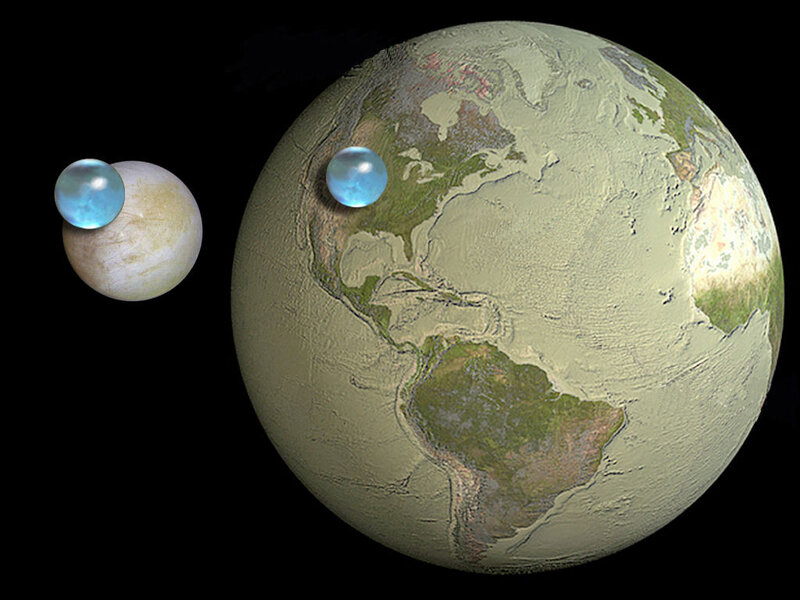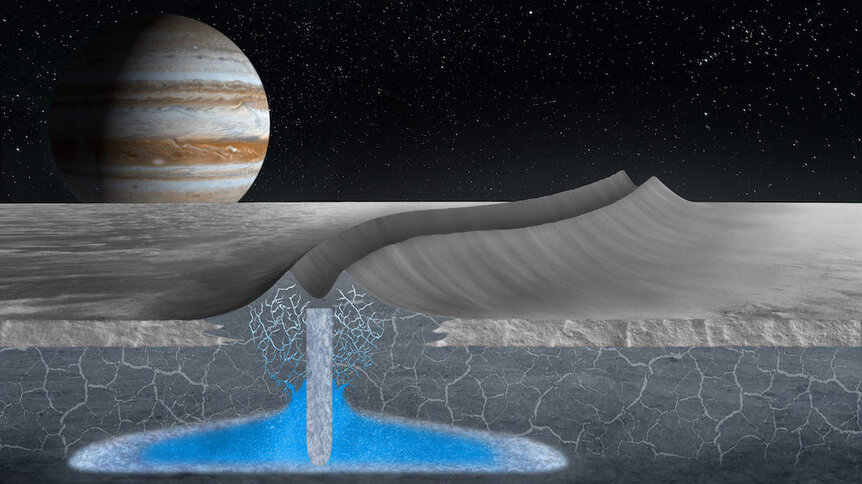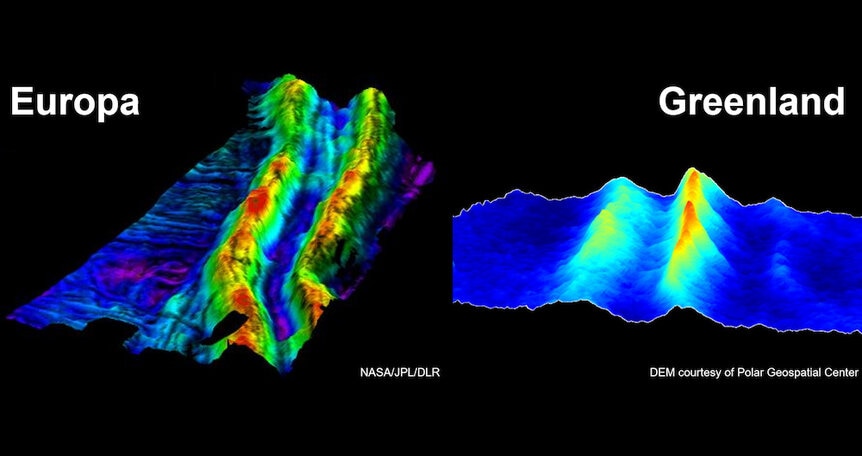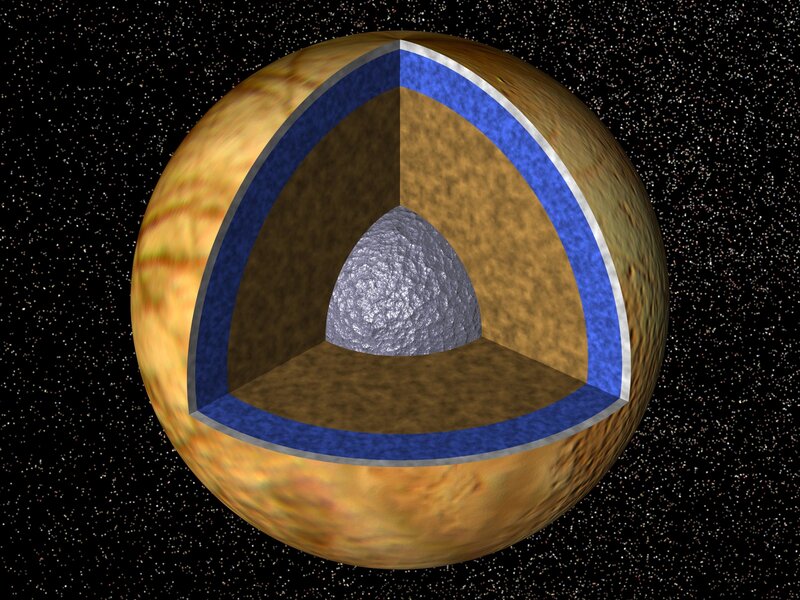Create a free profile to get unlimited access to exclusive videos, sweepstakes, and more!
Jupiter's moon Europa is covered in weird double ridges. Now one's been spotted in Greenland
These ridges may support the idea of life swimming in Europa's undersurface ocean.
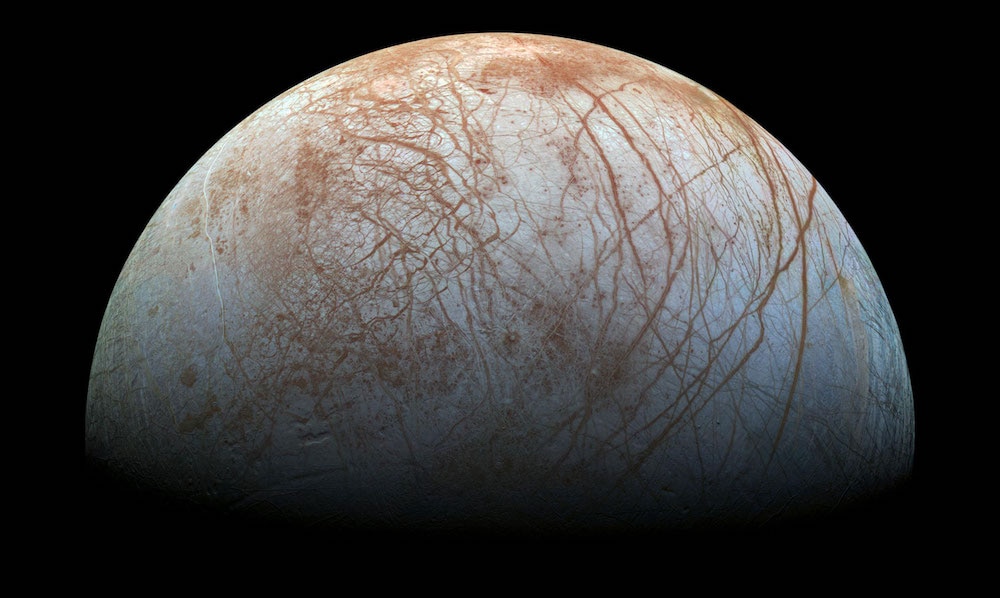
Europa is one of the most intriguing worlds in the solar system.
It’s the smallest of Jupiter’s big moons, and just a wee bit smaller than our own Moon. When the two Voyager spacecraft flew by in 1979 they sent back relatively high-resolution images of it, revealing several surprises. One is that the surface is globally very smooth, with very few craters. That implies the surface is young; any old craters must have been smoothed over, repaved in relatively recent geologic history.
Another is that the surface is mostly water ice, covered with darker streaks of reddish brown material, probably complex organic molecules called tholins. There are many other features like chaotic terrain, ridges, and more, and — long story short — over the years it became more and more clear that Europa likely has a thick ice shell surrounding a global ocean of liquid water, probably briny, over a mantle of rock. In fact, Europa likely has more water in it than Earth does on its surface!
The ocean is kept warm by tidal stress from Jupiter’s gravity, which perpetually squeezes and compresses the moon as it orbits the planet on a slightly elliptical path. The darker tholins might be the result of molecules brought up to the surface through cracks that then get bombarded by radiation from Jupiter’s immensely powerful magnetic field.
That brings up the possibility of life. If those molecules can be brought back down into the ocean, they could be the precursors of biology. Could there be alien fishies swimming in the permanently sunless depths?
This question drives a lot of study of Europa. For it to work, the water from below has to interact with the surface somehow. Can that happen?
A new study may have found the connection. A team of scientists looked at a weird ridge in Greenland that is similar to structures on Europa, and think they’ve come up with a formation mechanism that has implications for life under Europa’s shell [link to paper].
Europa is covered in odd double ridges; two ridges running parallel along a trough between them. These ridges can be hundreds of meters high and hundreds of kilometers long, and they are the most common surface feature on the moon. There have been several different mechanisms proposed for their formation, most involving water near the surface interacting with the shell and shell deformation through compression, or heating as parts of it are sheared sideways, and the like.
Such ideas are limited by the lack of such structures here on Earth. Ubiquitous they are on Europa, but locally they’ve never been spotted.
Until recently, that is. A recent survey used to create digital elevation models showed a double ridge on the ice in northwest Greenland, two long, parallel hills on either side of a trough. The hills are low, about 2 meters high, and run for 800 meters along their length. One key characteristic is the ratio of the height of a given ridge to the distance across the trough measured from ridge peak to ridge peak. On Europa it’s roughly 0.6, and — once the difference between Europa’s and Earth’s gravity is accounted for, since our stronger gravity makes hills slump if they get too big — for the Greenland ridge it’s about 0.4, which the scientists claim is consistent to the European ridge ratio. That’s important, if the formation mechanism is the same.
So maybe they form much the same way. How did the one on Earth form?
Given the ice and seasons in that region, the scientists think it’s actually a multi-step process. The surface ice is porous and forms a layer 10 or so meters thick. Below that, observed using ground-penetrating radar, is a water sill, a flattish intrusion of water — think of it as a shallow undersurface river that doesn’t flow — fed by surface melt in warmer weather. Underneath that is very hard, impenetrable ice.
When it gets cold, the liquid water sill freezes from the outside in. Water expands when it freezes, so this puts a lot of outward pressure on the ice around it. The ice under it is very hard, but the ice above it is porous and weak, so the water tends to expand upwards, freezing in place and forming a vertical slab of harder ice.
If the sill thaws a bit, or more water runs into it, the processes can repeat. But now there’s a vertical plug of harder ice above the sill, like a wall running down the middle of a river. That stays put, while the still porous ice on either side gets pushed up from below by the freezing sill. Lather, rinse repeat. Eventually you get two ridges on either side of the sill, pushed up in parallel down the length of the sill. The height of the ridges and the distance between them depends on a lot of factors but the ratio stays relatively constant down the length.
OK, so if that works for Greenland, what about Europa? It doesn’t have thaw and freeze seasons, and no surface water. But if there are cracks under the ice shell where it meets the ocean, then tides from Jupiter can force the water up toward the surface, which is how a Europan sill could be made. In that case, the same physics takes over, and the double parallel ridges form like they did in Greenland.
If that’s the case — and remember this is just a hypothesis, though based on actual observations of such a structure up close on Earth — then it has implications for life under the moon.
The rocky mantle provides minerals to the watery ocean, making it briny. If it then gets up to the surface enough to form the double ridges, it could also interact with Jupiter’s radiation, creating more complex molecules that are then cycled back into the ocean. In that case, you have all the ingredients for life — it’s also entirely possible there are hydrothermal vents at the bottom of Europa’s ocean, which could provide energy from heat and nutrients as well.
It’s a very compelling narrative, with the only caveat that we have no idea if this works or not. Europa may be teeming with weird marine life, or it may be completely sterile. We don’t know about the structure and evolution of the ice shell, the size, depth, and composition of the water, or what the ocean floor looks like there. Happily, a mission to the moon is being built by NASA right now. Called Europa Clipper, it’ll map the surface in detail, including mineralogical and chemical surveys, and will do ground-penetrating radar observations, all in the hope of understanding Europa enough to see if conditions there are favorable to life.
This is a real thing, and will really happen. Launch is in 2024 and orbital insertion in 2030. That’s really not that far in the future, and who knows? It may not find life, but it may provide enough evidence to look further. And no matter what it sees, we’ll get a far better look at this weird little moon, and we’ll learn more about it.
My thanks to lead author Riley Culberg for discussing this with me and supplying the nifty 3D plots of the two ridges.
